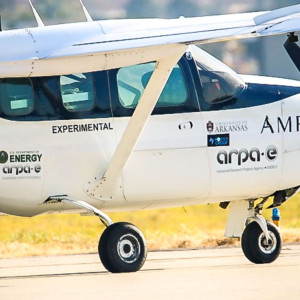New silicon-powered electric motor could change aviation forever


A hybrid Cessna 337 aircraft in Southern California has successfully completed a test flight using a new silicon carbide-based motor system. The plane, equipped with both a gas-powered engine and an electric motor, demonstrated that a smaller and more efficient silicon carbide inverter could replace traditional systems used in hybrid aircraft. Researchers from the University of Arkansas' Power Group developed the experimental inverter, which was tested in partnership with Ampaire and Wolfspeed.
The results mark a major step forward for energy-efficient aviation. The project was funded by the U.S. Department of Energy's Advanced Research Projects Agency-Energy (ARPA-E).
"We were the first university to do this for a hybrid electric aircraft[1]. That's a feather in our cap," explained Alan Mantooth, Distinguished Professor of electrical engineering and computer science and the lead researcher on the project.
Silicon carbide's edge over silicon
Most modern electronics--from phones to cars--rely on silicon transistors. These tiny switches power the circuits that make devices function.
However, silicon transistors waste energy as heat each time they switch on and off. Silicon carbide changes that. It allows transistors to switch up to 1,000 times faster, dramatically improving efficiency.
This also makes supporting components like inductors, transformers, and capacitors much smaller and lighter, a key benefit for aviation. "Imagine a race car with a big 350 engine that weighs hundreds of pounds. What if you had that same power, but I gave you something that would fit in your hand?" said Chris Farnell, an assistant professor and first author of the paper.
The UA Power Group is already a global leader in silicon carbide research. Despite its advantages, the material has faced challenges due to high production costs. "Silicon is made from dirt, and nothing is cheaper than dirt," Mantooth remarked.
But costs are dropping as manufacturing improves. Smaller, lighter silicon carbide systems reduce overall expenses, making the technology appealing to major automakers. "If the overall system gets cheaper, then Ford cares, Toyota cares.
That's why it ends up in cars," Mantooth added.
[embedded content]
Overcoming aviation's electrical challenges
The test aircraft[2] used a silicon carbide-based inverter to convert battery power into alternating current for the motor. The compact design is ideal for small airplanes, where weight and space matter most. "You're able to remove stuff and give passengers more legroom," Farnell noted.
The lighter system helps reduce energy use during takeoff and flight. However, designing electrical systems for aircraft[3] poses unique challenges. They must handle vibration, landing shocks, and changing atmospheric conditions that can affect insulation and cause electrical discharges.
Silicon carbide's higher switching speed also increases electromagnetic interference, which can disrupt other onboard systems. The successful test flight showed the UA Power Group engineers could manage these challenges effectively.
From lab to runway
Testing in real-world conditions is uncommon for university researchers, but the UA Power Group sees it as essential for progress. The project gave students invaluable hands-on experience.
"The students got a second-to-none experience. They got to do some hands-on engineering in addition to their scientific work, and they went on and got great jobs," Mantooth shared[4]. The research team included graduate students Anna Corbitt, Wesley G.
Schwartz, and Asif Faruque, along with faculty members Yue Zhao and David Huitink. Industry collaborators included Ampaire and Wolfspeed. This fall, the UA Power Group will open[5] a new Multi-User Silicon Carbide Research and Fabrication Laboratory to advance silicon carbide microchip research and connect university innovation with semiconductor manufacturers.
With this successful test flight, silicon carbide technology has proven its potential to transform not just hybrid aircraft, but the broader future of electric transportation.
The study was published[6] in IEEE Transactions on Power Electronics.